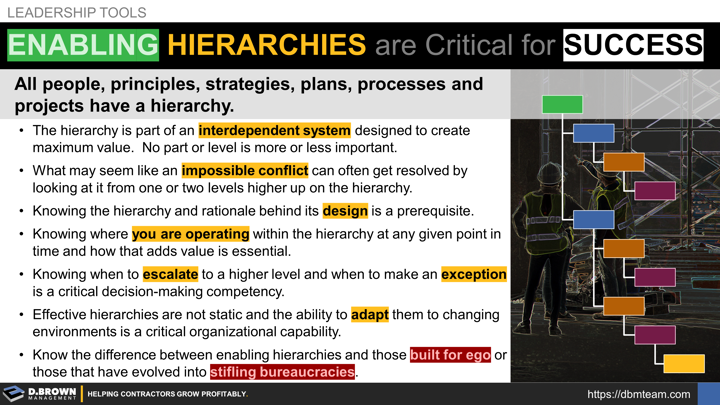At roughly every tripling of headcount, a contractor's organizational structure (hierarchy) must evolve alongside its strategies and systems. Everyone plays a different but equally important role, whether it is front-line execution, the final decisions on strategic direction, the various levels supporting of strategic decisions, the management that creates consistent outcomes, or the board of directors governing the whole thing.
Depending on where your company is at in the stages of growth, some of these levels of hierarchy may not be required or may be merged together requiring the people in those roles to manage what John Maxwell describes as "The Multi-Hat Challenge" in The 360 Degree Leader.
We are not going to cover all aspects of Organizational Design and Organizational Development, or how to integrate these with strategic choices and the business model at different stages of growth. These are just some basic principles around hierarchies to use when you are looking at yourself, your team, project, and company.
- The hierarchy is part of an interdependent system designed to create maximum value. No part or level is more or less important.
- What may seem like an impossible conflict can often get resolved by looking at it from one or two levels higher up on the hierarchy.
- Conversely, what may seem simple from one level can often be far more difficult when it is being executed one or two levels lower on the hierarchy. Regularly "Go See" the work being done first-hand, including any problems being experienced and opportunities.
- As a contractor navigates through stage 3 of growth, both the benefits and the conflicts across functions become increasingly more difficult to see as well as significantly more valuable or costly.
- Knowing the hierarchy and rationale behind its design is a prerequisite.
- Knowing where you are operating within the hierarchy at any given point in time and how that adds value is essential.
- Knowing when to escalate to a higher level and when to make an exception is a critical decision-making competency.
- Effective hierarchies are not static and the ability to adapt them to changing environments is a critical organizational capability.
- Know which phase of development you and your team are at as you navigate the stages of growth. The talent shortages that will continue to worsen through 2030 will tend to lead growing contractors toward more "Hollow" management teams which opens them up for risk, stunts growth, and impacts succession.
- Prepare for succession at every level - if you are growing, this should be a 3:1 ratio.
- Know the difference between enabling hierarchies and those built for ego or those that have evolved into stifling bureaucracies.
Hierarchies and Winning Projects
Remember that when it comes to negotiating projects with a select group of project owners, one of the key things they are looking for will be your capacity to build their project safely and efficiently. A large part of this comes down to your management structure (hierarchy) including safety and quality control.
Determining the best next steps with your organizational structure has a lot of nuances, many of them both difficult and sensitive. Please contact us to confidentially discuss the specifics of your situation. We will share with you anything we've learned that will help.

